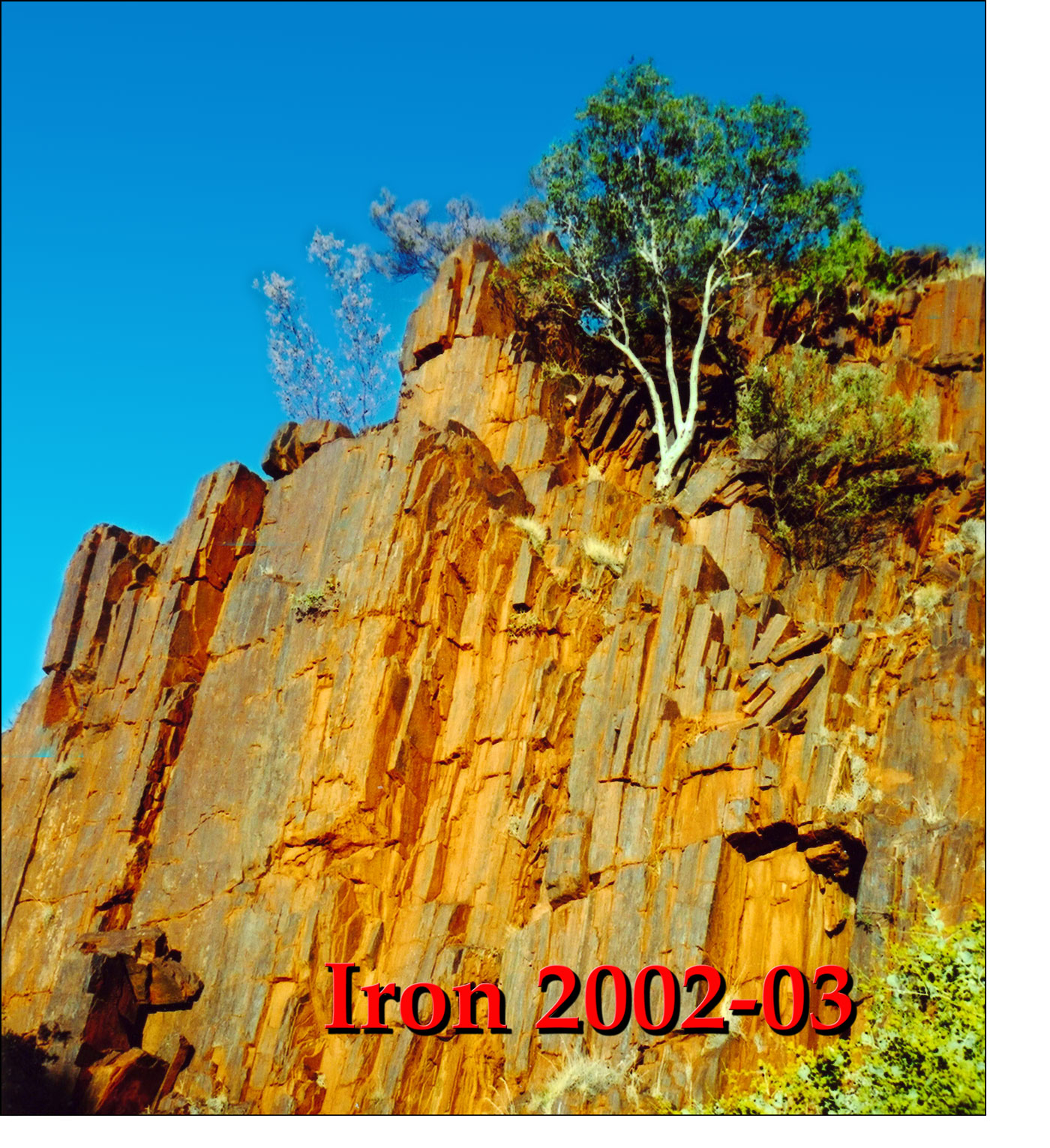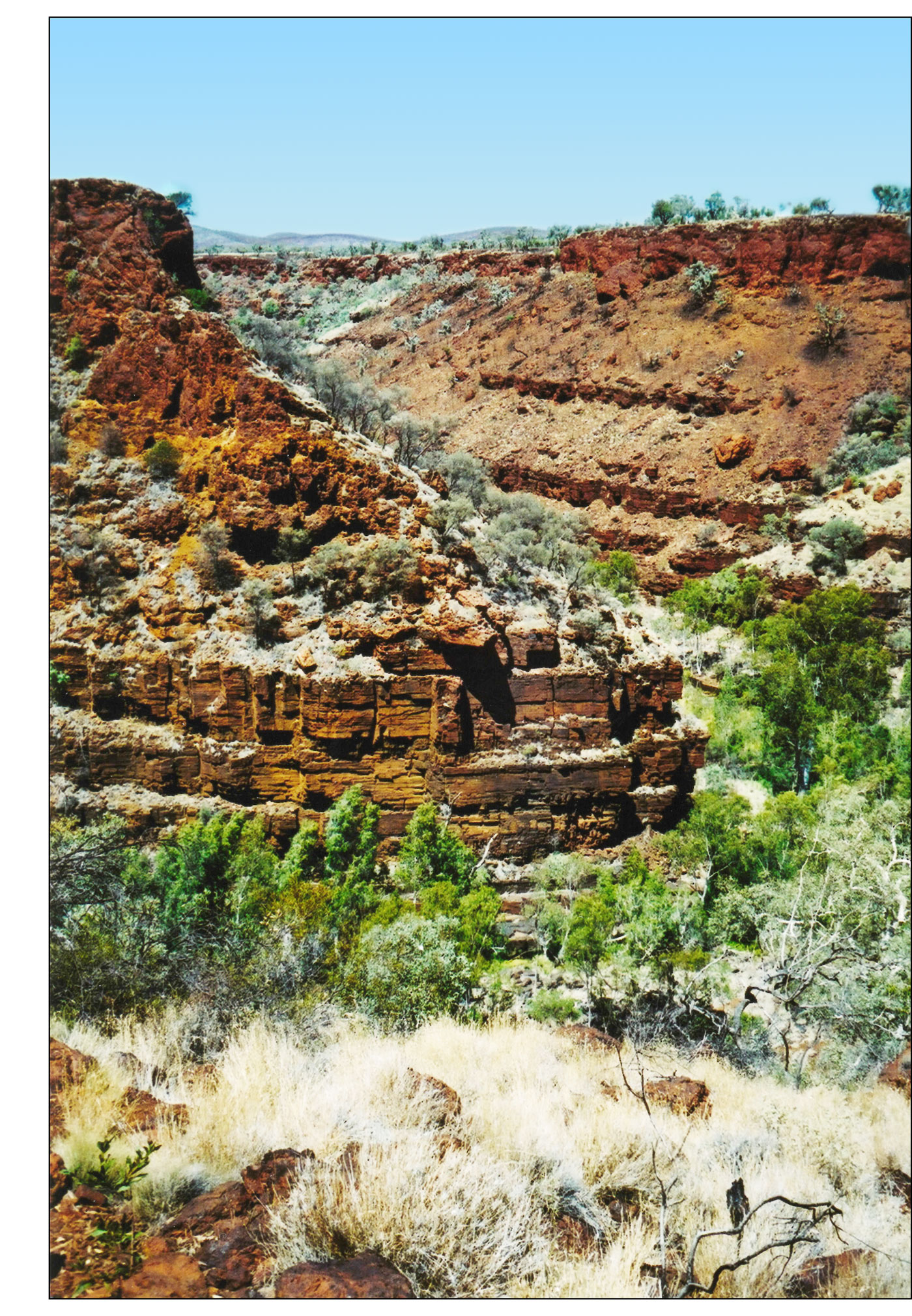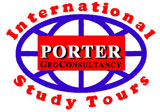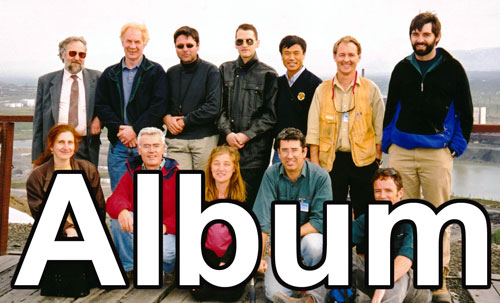| |||||||||||
|
Iron 2002-03 Key Iron Deposits of the World September 2002 & March-April 2003 | |||||||||||
|
| |||||||||||

Porter GeoConsultancy continued its International Study Tour series of professional development courses by visiting a selection of the world's key iron ore deposits in two separate modules.
The first module was for 7 days in September 2002, visiting deposits in the Pilbara of Western Australia. This segment was undertaken in conjunction with the major Iron Ore 2002 Conference in Perth, convened by the AusIMM (Australasian Institute of Mining and Metallurgy) and CSIRO (the Australian Commonwealth Scientific and Industrial Research Organisation) on 10 and 11 September, 2002, immediately prior to the tour. The second module was in March and April of 2003, divided into two parts. Module 2A, in South Africa, involved classroom and field workshops as well as visiting major deposits in the Sishen District of the Northern Cape and the Thabazimbi mines of the Northern Province. Module 2B, was in Brazil, during April 2003, and involved classroom and field workshops as well as visits to the three iron producing regions of the country, namely, the Serra dos Carajás in Para State in the north, the Quadrilatero Ferrífero to the south in Minas Gerais State, and the Corumba - Urucum district in the state of Mato Grosso do Sul to the west. Participants were able to take any of the 3 parts of the tour, namely Modules 1, 2A or 2B, up to the full tour, as suited their interests or availability, joining and leaving at the nominated start and end points of each. Module 1 commenced with an introductory meeting and dinner in Perth, Western Australia in the early evening of Wednesday 11 September 2002, and ended on return to Perth airport at 9:00 pm on the evening of Wednesday 18 September. Module 2A began in Johannesburg, South Africa, on the evening of Tuesday 25 March, 2003, and finished after the expert workshop at Rand Afrikaans University in Johannesburg 6 days later, on the afternoon of Monday 31 March, 2003. Module 2B commenced when the through-going group and new starters assembled at Marabá airport, Para State, Brazil, on the morning of Wednesday 2 April, 2003 and ended at São Paulo Congonhas airport on the evening of Thursday 10 April following the Corumba-Urucum visit. The countries/regions and deposits visited were as follows:
• Mount Whaleback, Jimblebar and Orebody 25 mines - high grade, large tonnage hypogene martite and microplaty hematite ore within the 2.5 to 2.45 Ga Brockman Iron Formation, and supergene martite-goethite ores within the 2.6 Ga Marra Mamba Iron Formation ..... Thursday 12 September, 2002. • West Angeles - mainly martite - ochreous goethite ores within the Marra Mamba Iron Formation, following a traverse of the Dales Gorge Member of the Brockman Iron Formation in Cathedral Gorge (image above) en route ..... Morning of Friday 13 September, 2002. • Yandicoogina - a Miocene Channel Iron Deposit developed within an extensive palaeo-channel incised into the 2.45 Ga Weeli Wolli Formation and 2.5 to 2.45 Ga Brockman Iron Formation .... Afternoon of Friday 13 September, 2002. • Hamersley Basin Field Workshop - detailed geological briefing on the geology and mineralisation of the Hamersley Basin by Tony Harding of Rio Tinto Iron, followed by field traverses across the succession and iron formations (e.g., Brockman Iron Formation in image below) ..... Saturday 14 and Sunday 15 September, 2002. • Mount Tom Price - large tonnage, high grade hypogene micoplaty hematite, mainly within the Dales Gorge and underlying Colonial Chert Members of the Brockman Iron Formation, ..... Monday 16 September, 2002. • Marandoo - supergene martite-goethite ore ranging to martite-ochreous goethite, mainly developed within the Mt Newman Member of the Marra Mamba Iron Formation ..... Morning of Tuesday 17 September, 2002. • Paraburdoo - massive to porous and mostly micro-platy, high grade hematite with lesser goethite and limonite within the Tertiary weathering profile of the Dales Gorge and Joffre Members of the Brockman Iron Formation. The visit only entailed a brief overview ..... Afternoon of Tuesday 17 September, 2002. • Robe River Mesa 'J' - remnants of extensive Tertiary Channel Iron Deposits composed of zoned goethite, limonite, hematite and maghemite pisolites to oolites, preserved as a series of mesas, mantled by hard goethitic pisolitic deposits ..... Thursday 18 September, 2002.
• Thabazimbi Iron Deposits , ~200 km north of Johannesburg, hosted by the basal 80 m of the Penge Iron Formation, which is separated from the thick underlying Malmani Dolomite by a 10 m chert bed. These units are all part of the of the Palaeoproterozoic Transvaal Supergroup within the extensive Transvaal Basin ..... Wednesday 26 March, 2003. • Travelling from Thabazimbi in Northern Province to Kathu, some 700 km to the west in the Northern Cape Province ..... Thursday 27 March, 2003. • Sishen Iron Deposit - a unit of strongly ferruginous chert breccia that grades upwards into a disturbed section of the Early Palaeoproterozoic Manganore Iron Formation, wedged between the underlying thick Campbellrand carbonates and the unconformity at the base of the Mid to Late Palaeoproterozoic Gamagara Formation clastic sequence. The iron formation and Campbellrand carbonates are part of the Transvaal Supergroup, deposited between ~2.4 and 2.1 Ga within the Transvaal Basin ..... Friday 28 March, 2003. • Sishen South, an exploration project ~65 km south of the Sishen mine where the Manganore Iron Formation is exposed over a 14 km strike length. The visit included studying drill core and a traverse of the host succession and iron formation ..... Saturday 29 March, 2003. • Beeshoek Iron Deposit and Field Traverse, ~70 km to the south of Sishen, exploiting i). hematised cherty banded iron formation; ii). hematised finely banded iron formation; iii). unconformably overlying conglomerate ore; and iv). detrital ore. The visit also included a district wide traverse of the host sequence ..... Sunday 30 March, 2010. • Johannesburg Workshop - South African Iron Deposits, an overview classroom workshop led by internationally renowned expert Professor Nic Beukes at the Rand Africaans University in Johannesburg ..... Monday 31 March, 2003. • Travelling from Johannesburg in South Africa, via São Paulo and Belem to Marabá in Para State, Brazil ..... Tuesday 1 and Wednesday 2 April, 2003.
Carajás District, Pará • Carajás Complex - involving an expert workshop presented by CVRD (Vale) staff, followed by traverses and drill core study of the sequence and ore in the N4 and N5 mines. The Carajás ores lie within the ~2.7 Ga Grão Pará Group, which is composed of meta-basalts, meta-sediments, ironstones and lesser meta-rhyolites. The ore deposits are hosted by an ~300 to 400 m thick banded chert-hematite banded iron formation, sandwiched between thick lower and upper volcanic unit ..... Wednesday 2 and Thursday 3 April, 2003. 
• Travelling from Carajás, via Marabá and Brasilia to Belo Horizonte in Minas Gerais State, Brazil ..... Friday 4 April, 2003. Quadrilátero Ferrífero, Minas Gerais • Quadrilátero Ferrífero Field Workshops - led by Professor Eduardo Ladeira of the Universidade Federal de Minas Gerais to study the geology, structure, setting and iron formations of the host successions to the major iron deposits of the district. The host Minas Supergroup is an up to ~6000 m thick, ~2.58 to 2.10 Ga sedimentary pile, deposited as a continental marine sequence that comprises clastic, carbonate and chemical-sedimentary units ..... Saturday 5 and Sunday 6 April, 2003. • Itabira Complex, located within an outlier of the Minas Supergroup in the eastern high-strain domain of the Quadrilátero Ferrífero, with ore that comprised both hard, high grade, 67% Fe hematite and friable lower grade, 45 to 50% Fe itabirites that had to be upgraded ..... Monday 7 April, 2003. • Casa de Pedra Mine located in the transition from the western low-strain, to the eastern high-strain domains, near the southern extremity of the tight, complex, thrust bounded and reclined Moeda Synform which has been influenced by at least four deformational events. The principal ore lenses, the Main and West orebodies, are composed of granular hematite and magnetite, and of specularite and goethite respectively ..... Tuesday 8 April, 2003. • Travelling from Belo Horizonte, via São Paulo and Campo Grande to Corumba ..... Evening Tuesday 8 and morning Wednesday 9 April, 2003. Corumba-Urucum District, Mato Grosso do Sul • MCR Corumba Iron Mine - hosted by the Neoproterozoic ~547 Ma, up to 300 m thick, Santa Cruz Formation, composed of hematite-rich banded iron formation with manganese oxide intercalations. The iron formation averages 54% Fe, embracing substantial tonnages of high grade, enriched ~63% Fe ..... Wednesday 9 April, 2003. • CVRD Urucum Iron - Manganese Mine - hosted by the same sequence as the Corumba Mine detailed above, but including locally more manganese rich beds ..... Thursday 10 April, 2003. • Travelling from Corumba, via Campo Grande to São Paulo ..... Afternoon and evening of Thursday 10 April, 2003. The tour ended in São Paulo Congonhas airport at 9:00 pm on the evening of Thursday 10 April. The group members had each made their own arrangements to fly out of São Paulo to disperse around the world. The tour was planned, organised, managed and escorted by Mike Porter of Porter GeoConsultancy Pty Limited. | |||||||||||
| |||||||||||
|
| |||||||||||












